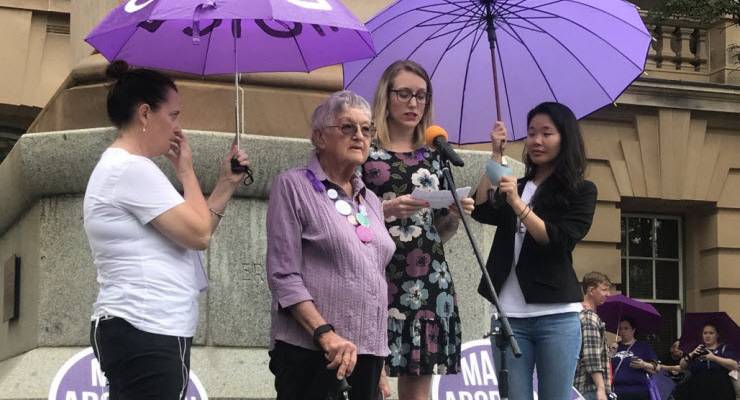
You can see how long these battles have taken in the faces of the women who were on the front line.
A few days before abortion was decriminalised in Queensland in October 2018, Beryl Holmes stood, supported by a cane, on the steps outside state parliament house for a rally in support of the bill. She had been fighting for this for almost 50 years.
In the 1970s Holmes co-founded Children by Choice, a pregnancy counselling service that has survived on a shoestring, through decades of hate mail and a few too many bricks through the window, as a safe place for women to find information, support and often money to access abortion safely.
In September 2019, a month before abortion was decriminalised in New South Wales, Wendy McCarthy stood out side state parliament at a rally to support the legislation. The Women’s Electoral Lobby co-founder was one of 80 women who put their names and the fact that they’d illegally terminated pregnancies in a full page advertisement in a national newspaper in the early 1970s, and she had pushed for change ever since.
These landmark reforms marked the end of decades-long campaigns and parliamentary inquiries propelled by women and their doctors who no longer wanted to be treated as criminals. But they did not herald instantaneous equity in family planning services across Australia.
In every debate for decriminalisation, proponents for the bills and those holding dead foetus pictures outside clinics agree on one thing — taking the procedure out of criminal legislation is the first step to improving access to it. But one state is still waiting to take that first step.
When abortion was decriminalised in NSW, many outlets wrongly reported it was the “last” Australian state to take the procedure out of its criminal code, but in fact South Australia is yet to do so.
South Australia is often held up as the gold standard of abortion provision as it was one of the first to modernise its abortion law. Unlike most parts of Australia, you can access a termination there at no cost through the public system, which has no doubt benefitted countless women without means.
But the law in SA was last changed 50 years ago, before abortion drug mifepristone was even invented, and so all terminations — even taking two pills for a medical abortion — must happen at the handful of approved hospitals in the state, most of which are in Adelaide. This means a woman needs to travel and in some cases stay overnight instead of terminating a pregnancy in the privacy of her own home.
Legislation to fix this was introduced in 2018 but it never got across the line. Since then the South Australian Law Reform Institute has recommended decriminalisation but the attorney-general is yet to put forward her bill to do so.
Even once South Australia has passed this legislation, however, it won’t be some unifying moment in terms of how women across the nation access abortion.
A 2018 study published in the Medical Journal of Australia found 26% of women surveyed had had an unplanned pregnancy in the previous decade and nearly a third of these were terminated. Abortion is common but the haphazard way it is regulated across Australia is not, compared to other routine procedures. A woman seeking an abortion in Adelaide has a completely different set of options to a woman seeking an abortion in Townsville.
Those who fought for decriminalisation say that if a woman wants to terminate a pregnancy, she will find a way to do so and the law determines whether she can do so safely. They also make the case that public provision of abortion, which most benefits women who don’t have hundreds or thousands of dollars at short notice to go to a private clinic, was impossible so long as hospitals could hide behind the law.
Tasmania decriminalised abortion in 2013 but women still struggle to access it locally. In 2018, Hobart’s single surgical abortion provider closed after 17 years and the gap left in provision was so large that it sparked a national conversation about abortion access as patients were forced to travel interstate at huge personal cost.
Surgical abortion access has been restored in Hobart but it’s slim pickings elsewhere — as has been highlighted over the past few months when women in Launceston were having to travel south during a pandemic because the local hospital wouldn’t help.
Before the coronavirus outbreak hit there was debate about how conscientious objection clauses in the government’s proposed religious freedom bill would impact abortion access. But the reality is doctors in Australia can already object, on religious grounds, to providing contraception and abortion. GPs do so verbally and via signs in their offices that outline they won’t see people about these issues, while religious hospitals can turn these patients away without repercussion. This disadvantages women in regional and rural areas where there may only be a handful of GPs to choose from.
In New South Wales, huge chunks of the state remain unserviced. Just last year women in the Riverina region were making a 500km round trip to Canberra for surgical abortions after an option for an 130km round trip to Victoria was cut off.

Medical abortions are supposed to be the convenient solution for women outside of major cities, allowing them to terminate a pregnancy in their own home (at up to nine weeks gestation). But even if they do find a registered prescriber and cooperative pharmacy they face few options in the case of a complication.
Last year a woman in Narrabri was turned away from three hospitals closest to her after a failed medical abortion and she had to drive and stay overnight in Newcastle to access treatment. Months later Wagga Wagga hospital inserted an IUD into a woman who was pregnant and then refused to remove the device or perform a termination; the single mother had to go to Canberra and fork out hundreds of dollars at a private provider.
In Queensland, the government promised to improve public provision of abortion after decriminalisation, and this process is well underway as the health department establishes referral pathways in the public system. But it is a mammoth task. Australia’s biggest abortion provider, Marie Stopes Australia, has been chartering private flights from Brisbane to Rockhampton and Townsville during the pandemic as there are no other options for women there.
No one is going to stand on Macquarie Street and cheer when hospitals in the Riverina begin quietly accepting women who need abortion care, nor will they celebrate in Coober Pedy when women can access telehealth abortion without driving to Adelaide. These changes will not be made by parliaments but by doctors who want to better serve their patients and health bureaucrats who help them to do so.








Thanks Gina for this detail that would otherwise be obscure to bloke to whom this is invisible. Just on this one issue we have a long way to go on gender equity. In the 70s I deludedly thought authentic gender equity would have been long achieved by now. What perplexes new is that men do not have surrender authentic rights to facilitate gender equity. It is the surrender of unjust prejudice and misogyny that has proven so difficult.
When there was debate about legalising RU486 in Australia, my (now late) father would complain why was it not already legal, and he would add “it has been legal in France since the 1980s”.
Part of the rational behind bringing RU486 into the country was so women in remote areas could have access to abortions. Now instead of being at the mercy of Hospitals, they are at the mercy of Pharmacies and Doctors.
I believe the stories of these women because I have experienced it, though not recently. About 20 years ago I went to a doctor to get the morning after pill. He refused to prescribe it because it was against his religion (Catholic). I had to wait 4 hours for another Doctor to come on duty to get a prescription (which you needed then).
A few years later I had moved and I was going to a new GP. I went to get my script for the pill refilled. I didn’t initially think much when he asked why I was on it, and I was on it after having a cyst removed from my right ovary, the pill reduces re-occurrences. He asked for my medical records on this and I said ‘sure I will organise it’, and I walked out with the refill but it was not urgent and I was getting my records sent over. It was not until a couple days later when my housemate went to get the pill from him and he refused because she was using it as contraception that I realised what he was getting to with the conversation with me. When I went back with my records I noticed The Last Supper hanging on a wall in the hallway of his practice and it was crystal.
The Pill, a basic women’s right since the 60s/70s. There are doctors in Australia who won’t prescribe it. It is inconvenient in the city and means I have to see someone else, but imagine if these GPs were in the country. If these men were the only doctors for a hundred kilometres. What if it was a pharmacist who refused to fill the script and the next chemist was 500kms away.
Women need better health and protection for their health and GPs like this need to be struck off the register, but the ball-less AMA won’t do a thing. I know. I wrote to them about both instances.
Perhaps it is because the Catholic Church takes a back seat on policy in the UK, but I had an abortion in England in 1969, courtesy of the NHS, under legislation passed in 1967.
The religious right … sacred in the womb but exploit the hell out them the moment they breath.